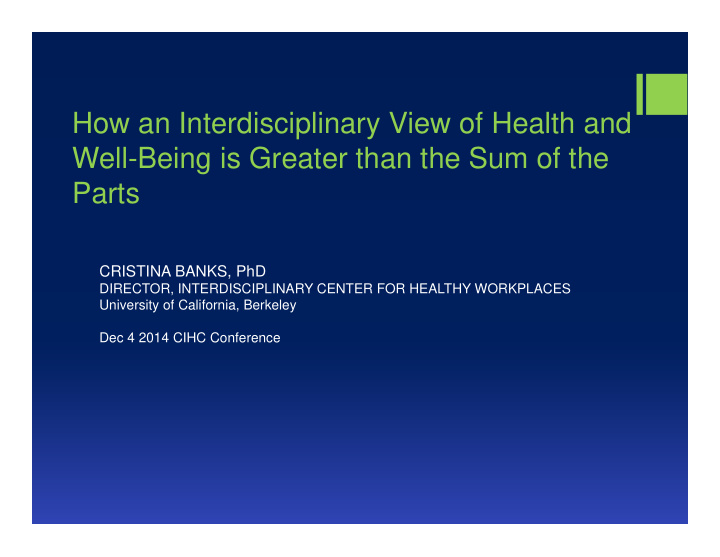



How an Interdisciplinary View of Health and Well-Being is Greater than the Sum of the Parts CRISTINA BANKS, PhD DIRECTOR, INTERDISCIPLINARY CENTER FOR HEALTHY WORKPLACES University of California, Berkeley Dec 4 2014 CIHC Conference
Health and Well-Being COMPONENTS Physical Psychological Emotional Social … not merely the absence of disease or infirmity
“The Box and everything that happens inside of it.” What are the environmental concerns? What are the sustainability concerns? What are the health & safety concerns? What are the well-being concerns? Can we address all concerns in the same place? At the same time?
MOTIVATOR FACTORS Sense of personal control Sense of personal achievement Status Respect &recognition Challenging/stimulating work Responsibility Opportunity for advancement Promotion Growth FLOURISH LACK OF HEALTH HYGIENE FACTORS Safety rules & protection Hazard identification & mitigation Elimination of toxins Salary/benefits Company policy and admin Interpersonal relationships Quality of supervision Job security Working conditions Work/life balance Derivative of Herzberg ‘Two Factor Theory’ 4
The Berkeley Way Project School of Public Health, School of Education, Psychology Department One building Created from scratch 7 stories Students, Faculty and Staff Two-year build
The Box Walls Offices Open space Atrium Plumbing Stairways Corridors Doors Windows Lighting HVAC
Everything Inside The Box Furniture Plants Desks Partitions Computers, sensors, devices, apps Wall color Play Equipment Kitchen/cafeteria Gym/Fitness Restorative rooms Lactation rooms Private rooms Collaboration centers Conference rooms Communications
Everything that happens inside The Box Company culture Leadership style Organizational policies Performance expectations Job design Training & development Work hours Social groups Compensation & rewards Wellness programs Food Counseling
How do you decide?
How do you decide? What drives employee physical and psychological health and well-being? How do you introduce them into the workplace in an integrated, mutually-supportive and internally- consistent way?
What drives employee physical and psychological health and well-being?
How do you introduce them into the workplace in an integrated, mutually-supportive and internally- consistent way?
INTEGRATION: Focus on the Employee’s Internal States PHYSICAL PSYCHOLOGICAL Rested, relaxed Sense of control Physical comfort Respected, supported Steady energy levels Socially connected Calm Free from harm, injury Well-nourished Happy, satisfied Energized Present, work ready Physically active Sense of accomplishment Absence of pain, managed Sense of fairness/equity Safe, secure Compatibility with company values
Link Between Physical/Psychological States and Organizational Attributes Physical & Psychological States Organization Attributes Respect Pay + leave policies Accomplishment Relationships Equity/fairness Ombudsman Present, ready to work Clinics Control Mental health access Physical activity Teamwork Happy, positive Attractive office design Ergo furniture Physical States Good food Rested, relaxed Limited work hours Comfortable Safeguards Safe, secure Open staircases Absence of pain
Exercise: Linking Internal States to Organizational Attributes Complete survey Report results
ORGANIZATIONAL CONTEXT ORGANIZATIONAL SUPPORT BEHAVIOR CHANGE ORGANIZATIONAL LIFE-CYCLE BASELINE FACTORS PSYCHO-SOCIAL SUPPORT physical environment performance management start-up vs. mature hierarchical vs. flat healthy food rewards/recognitions ergonomic fit DEMOGRAPHICS job/role design BELONGING inter-generational team building MOTIVATION FACTORS community involvement aging workforce leadership engagement SOCIO-POLITICAL CONTEXT work/life fit ENGAGEMENT diversity personal development employee-oriented programs country culture culture/values task forces autonomy Interdisciplinary Center for Healthy Workplaces, University of California at Berkeley Preliminary Framework
Recommend
More recommend